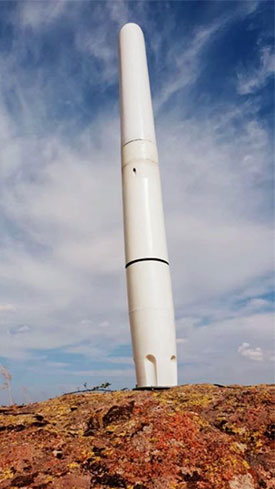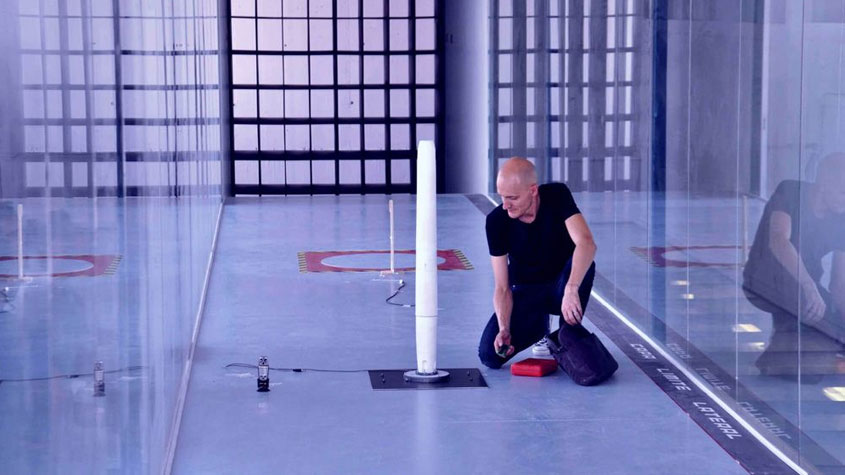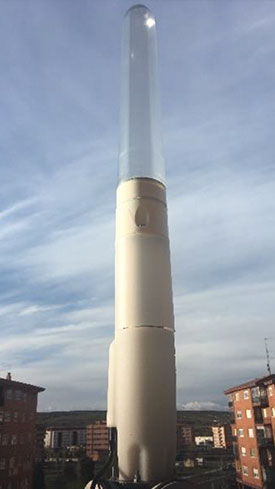Rethinking Wind Energy
Vortex Bladeless S.L. develops and markets bladeless wind turbines that do not need the shaft, gears, bearings or mechanisms normally worn out by friction.

This technology is based on aeroelastic resonance, which allows the turbine to harness the energy of forming vortices. A bladeless wind turbine consists of a vertical cylinder fixed with an elastic rod embedded in the ground. The movement of the upper part is magnetically restricted as this is where the largest oscillation amplitude occurs. The cylinder harnesses energy from the wind when it goes into resonance because of the aerodynamic effect known as vortex shredding. This then transforms the mechanical energy into electricity through an alternator.
An innovation inspired by the collapse of the Tacoma Narrows Suspension Bridge

Vortex Tacoma model (2.75m high)
in Valle de Ambes, Ávila
(Photo: © Courtesy of Vortex Bladeless S.L.)
In 1940, the world’s third longest suspension bridge was built in the US State of Washington on Route 16 as it passes through Tacoma Narrows. Four short months after its inauguration, the bridge began to oscillate and ultimately tore apart. This shocking structural collapse is one of the most widely used academic examples demonstrating how wind-induced aerodynamic resonances work.
In 2002, David J. Yáñez learned about this collapse while studying engineering at Valladolid University and then wrote the first patent for a machine capable of optimizing this type of aerodynamic resonance to generate electric energy.
It was a slender, vertical structure with a circular section that oscillated in the plane perpendicular to the wind direction. It was a machine capable of working without any shaft, gears, bearings or mechanisms and the device therefore did not require lubricants. Maintenance costs and repayment time were also reduced. The aim was to produce energy from the wind without requiring structures with blades, as is the case with conventional wind turbines. It was years later, in 2010, when David J. Yáñez and Raúl Marín Yunta filed patent ES2374233B1 through their company, DEUTECNO S.L.
After receiving support from the Repsol Foundation and winning other awards, they founded Vortex Bladeless S.L., for which two successive grants were secured. The company is currently manufacturing the first pre-series of 100 small units to develop the product sufficiently for bringing it to market.
Phases in the development of this technology
The first phase focused on understanding the aerodynamic phenomenon.
This type of aerodynamic resonance is usually considered a problem and there is considerable knowledge on how to avoid it. This, however, is not the case when trying to exploit this phenomenon. Thanks to the support of multinational companies such as Altair Engineering, Inc. and organizations such as Barcelona Supercomputer Center, the configuration has been optimized to maximize the machine’s performance.
The second phase focused on controlling the interaction of the structure with the wind in order to increase the range of wind speeds at which resonance occurs.

During the third phase, an alternator capable of properly converting oscillatory energy into electricity was developed. It is currently in its fourth and final phase, in which, after the “minimum viable product” is established, production, industrialization and marketing will follow.
International recognition

Vortex Nano model
(Photo: © Courtesy of Vortex Bladeless S.L.)
International interest in this project has been exceptional, especially from Asia, America and Europe. The team has received countless collaboration requests of various kinds from the academic and industrial sectors. For example, one of the world’s three largest wind power companies has proposed to undertake a collaborative project to analyze the potential of applying this idea to larger machines.
The response from the non-profit sector has also been excellent. Companies like SEO Birdlife, the UN, the European Commission, along with countless other national and international cooperatives, associations and institutions are helping to achieve the company’s goal or providing a variety of perspectives.
Protection goes hand in hand with industrial property for Vortex Bladeless
The first patent ES2374233B1, which has since been expanded to cover Europe and America (the United States and Mexico), as well as EP15771650, WO2017174161A1, WO2018149942A1, etc., protect innovations and the company itself through industrial property (patents and trademarks of Vortex Bladeless), which has always been considered to be the backbone of the entire project.
In fact, different patent families are a faithful reflection of the company’s trajectory. In each grant or competition that the project entered, the degree of protection provided to the technology has always been considered as a crucial aspect. Fortunately, as this type of wind turbine is the first of its kind, it is easy to earn the recognition of “novelty” and “inventive step” that are required in all patent offices around the world where the application for protection has been filed.
While all the technology of Vortex Bladeless is currently protected, the future approach will always be that of protection, which will perhaps be more focused on manufacturing processes and derivatives from the implementation in different areas.